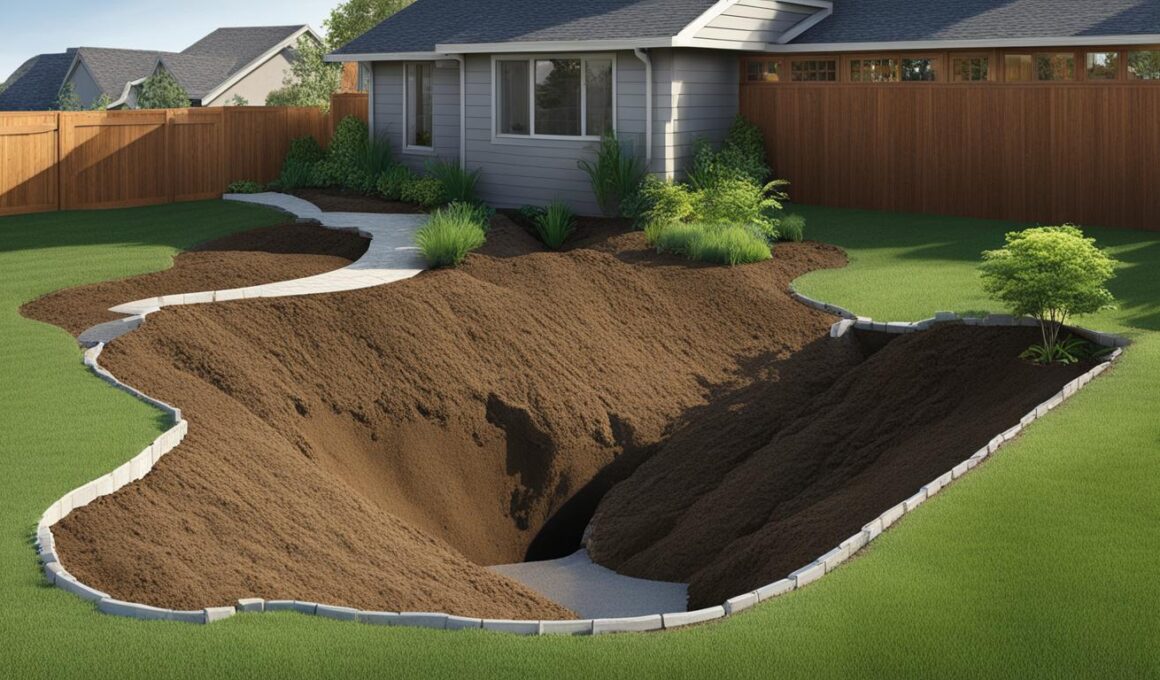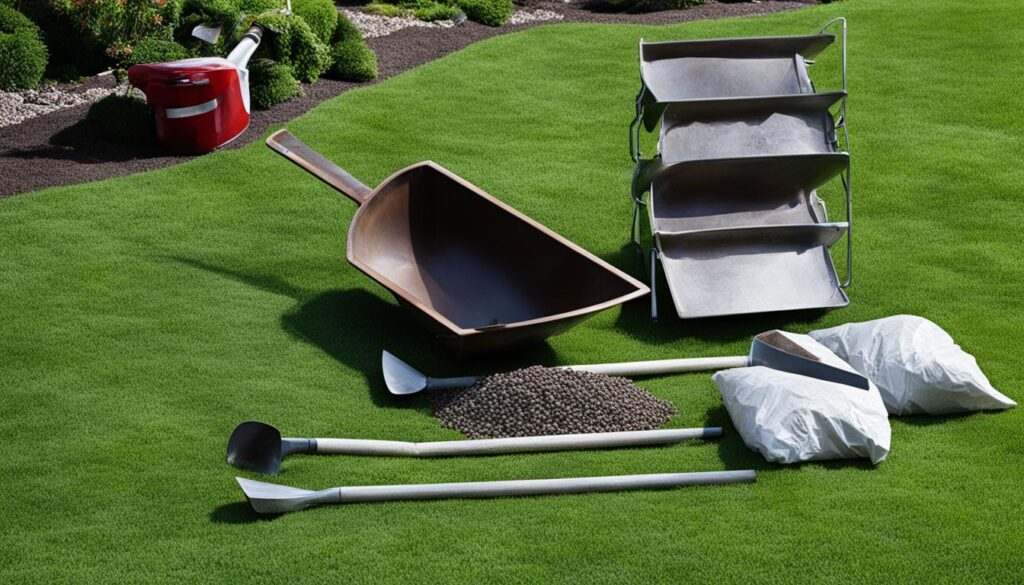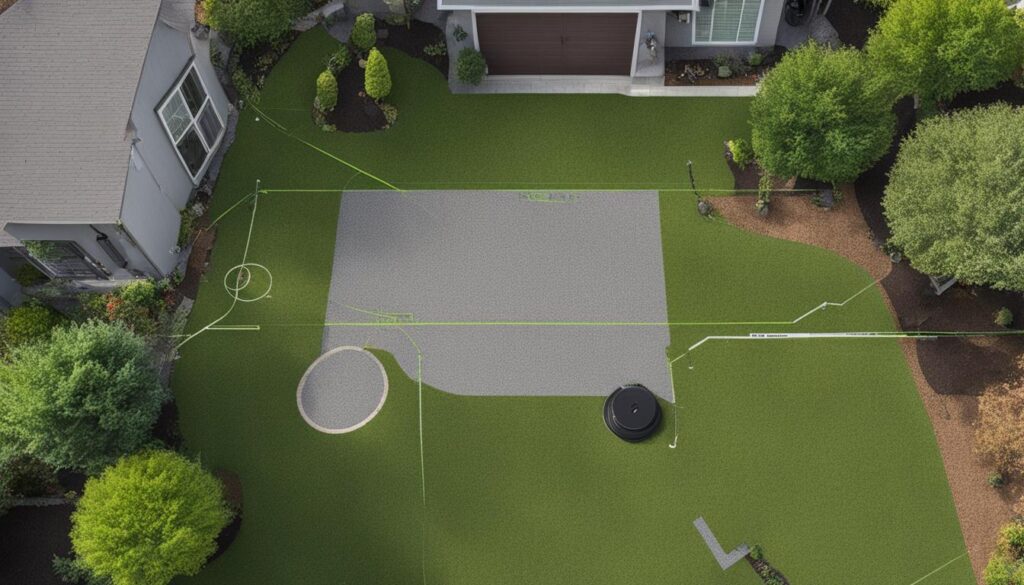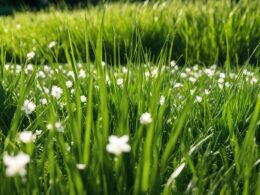Welcome to our DIY guide on how to install a French drain in your yard effectively. If you’ve been experiencing poor drainage in your yard or have been struggling with excess water runoff and flooding, a French drain can be a practical solution. By diverting water away from your property, a French drain not only helps prevent flooding but also protects your yard from erosion and keeps your foundations dry.
In this comprehensive guide, we will take you step-by-step through the installation process, providing you with all the necessary information and tips to ensure a successful project. We will also discuss the benefits of installing a French drain in your yard, the materials you’ll need, the estimated cost, planning considerations, and maintenance tips to keep your French drain functioning optimally.
Whether you’re a seasoned DIY enthusiast or a beginner looking to take on a new project, our guide will equip you with the knowledge and confidence to install a French drain in your yard. Let’s get started and transform your yard into a well-drained and protected outdoor space!
Benefits of Installing a French Drain in Your Yard
Installing a French drain in your yard offers numerous benefits. It effectively controls water runoff and prevents flooding, acting as a reliable solution for managing excess water in your yard. In some cases, a French drain can even serve as an alternative to traditional gutters, directing water away from your home’s foundation and protecting it from potential damage.
One of the key advantages of a French drain is its ability to reduce the risk of basement flooding. By diverting water away from your home’s foundation, it helps keep your basement dry and free from water damage, which can save you significant time, money, and stress in the long run.
In addition to preventing flooding, a French drain also plays a crucial role in preventing erosion around your property. By controlling the flow of water, it helps maintain the stability of your yard, protecting it from soil displacement and potential damage caused by erosion.
Another major benefit of installing a French drain is its ability to keep your foundation dry. Excess water around your foundation can weaken the structural integrity of your home and lead to various issues, such as cracks and leaks. By effectively draining water away from the foundation, a French drain helps keep it dry and reduces the likelihood of foundation-related problems.
Furthermore, installing a French drain can enhance the overall drainage system in your yard. By efficiently managing water runoff, it can help maintain a healthier and more sustainable environment, promoting the growth of your plants and preserving the integrity of your landscaping.
Overall, installing a French drain in your yard provides a range of benefits, including effective water control, reduced risk of flooding, erosion prevention, foundation protection, and improved overall drainage system. Consider incorporating a French drain in your yard to ensure optimal water management and maintain the integrity of your property.
Step-by-Step Guide to Installing a French Drain
Follow these steps to install a French drain near your home:
-
Dig a trench with the appropriate slope away from existing structures or areas prone to flooding.
-
Line the bottom of the trench with fabric mesh to prevent soil or debris from clogging the drain pipe.
-
Fill the trench with gravel to ensure proper water flow.
-
Install a drain inlet to allow surface water to enter the French drain.
-
Lay the perforated PVC pipe on top of the gravel with the perforations facing downwards.
-
Cover the pipe with more gravel and wrap the excess fabric around it.
-
Fill the remaining space in the trench with gravel or topsoil.
Remember to consult with an experienced contractor or plumber if you are unsure about the installation process.
Materials Needed for Installing a French Drain
To install a French drain, you will need the following materials:
- A shovel or trencher digger for digging the trench
- Wooden stakes and string for determining the slope
- Gravel for lining the trench
- Fabric mesh for preventing clogs
- Perforated pipe for drainage
- A small catch basin for the drain inlet
- Optional materials such as dirt or topsoil for filling the trench and landscaping materials for aesthetic value and erosion prevention
The quantity of materials will vary depending on the size of the project. Ensure you have enough gravel to adequately line the trench and enough fabric mesh to cover the drainage pipe. The catch basin should be appropriately sized to handle the surface water entering the French drain.
Cost Estimate for Installing a French Drain
The cost of installing a French drain will depend on the size and materials used. As an estimate, the materials for a 6-inch diameter, 10-foot-long perforated drain pipe French drain can cost around $241. This includes costs for gravel, wooden stakes, string, topsoil, fabric mesh, perforated pipe, catch basin, mulch, and sod. Additional costs may be incurred for tools and equipment if you don’t already have them.
To give you a better idea of the breakdown, here is a cost estimate for the materials needed:
- Gravel: $50
- Wooden stakes: $10
- String: $5
- Topsoil: $30
- Fabric mesh: $20
- Perforated pipe: $60
- Catch basin: $20
- Mulch: $30
- Sod: $16
Remember, these costs may vary depending on your location and the specific materials and quantities needed for your project. It’s always a good idea to obtain multiple cost estimates from suppliers and contractors to ensure you are getting the best deal.
Planning for French Drain Installation
Before embarking on the installation of a French drain, careful planning is crucial to ensure its effectiveness in solving your yard’s drainage issues. By implementing the following steps, you can ensure a successful installation:
Choose the Location
Identify the areas in your yard where water tends to pool or accumulate. These are the ideal locations for installing the French drain. Additionally, consider the proximity of a suitable outlet for the runoff water, such as a retention pond or an existing drainage system. This will help redirect the water away from your property and prevent further damage.
Check Zoning Regulations and Obtain Permissions
Before proceeding with any construction, it is important to familiarize yourself with the zoning regulations in your area. Ensure that installing a French drain aligns with the local regulations and guidelines. Additionally, obtain any necessary permissions or permits from your local municipality to avoid potential legal issues.
Calculate Gravel Requirements
To determine the amount of gravel needed for your French drain installation, calculate the length, width, and depth of the trench. Multiply these measurements to determine the cubic footage of gravel required. You can then convert this into the necessary amount of gravel bags or bulk gravel to purchase, ensuring you have enough for the entire project.
Consider Slope and Drainage
The success of a French drain relies on proper drainage. Ensure that the area you plan to install the drain has a sufficient slope to allow for water flow. This will facilitate the movement of water away from your yard and prevent pooling or flooding. Take accurate measurements of the slope to ensure an effective drainage system.
Beware of Buried Utility Lines
Before excavating the trench for the French drain installation, it is essential to identify and mark any buried utility lines in the area. Contact your local utility companies to obtain information on the location of these lines. This precautionary measure will prevent any accidents or damages to utility lines during the excavation process.
Maintaining a French Drain System
After installing a French drain, it’s essential to regularly maintain it to ensure optimal functionality. By following a few simple steps, you can keep your French drain system in good working condition.
Inspect and Clear Debris Regularly
To maintain your French drain, periodically inspect it for any signs of clogs or debris. Clearing any accumulated debris from the drain pipe is crucial to ensure proper water flow. You can use a garden hose or a plumbing snake to remove any obstructions and maintain the flow of water.
Monitor for Erosion and Soil Displacement
Check the area surrounding the trench of your French drain for any erosion or soil displacement. These issues can potentially lead to blockages or restrictions in the drain’s function. If any erosion or soil displacement is detected, address it promptly by filling and compacting the affected area with suitable soil or gravel.
Preventive Maintenance: Flushing the Drain
To prevent future clogs and ensure the smooth operation of your French drain system, consider flushing it with water every few months. This simple maintenance practice helps remove any accumulated dirt or debris and keeps your drain functioning optimally.
Address Repairs and Breaks
In the event that your French drain system breaks or comes apart, it may require repair or reassembly. If you encounter any issues beyond your expertise, it’s advisable to hire a professional to ensure proper repair and maintenance of your French drain system.
By following these maintenance practices, you can keep your French drain system in excellent condition and enjoy its benefits for years to come.
What Are the Benefits of Installing a French Drain in Your Yard?
Installing a French drain in your yard can provide numerous benefits. This type of drainage system effectively manages water runoff, preventing yard flooding and moisture buildup. It also helps in protecting the foundation of your home from water damage, making it a valuable investment for any property.
Conclusion
In conclusion, installing a French drain in your yard is an effective solution for addressing water drainage issues and protecting your landscape. With the right installation process and regular maintenance, you can ensure that your French drain functions efficiently and provides long-term benefits.
Consulting with professionals for complex installations or repairs is recommended to guarantee the best results. Their expertise and experience can help you navigate any challenges and ensure that your French drain is installed correctly.
By installing a French drain, you can maintain a dry and protected yard while preventing flooding and erosion. This investment in your property’s drainage system will not only enhance the aesthetics of your yard but also protect your home’s foundation from potential water damage in the long run.











